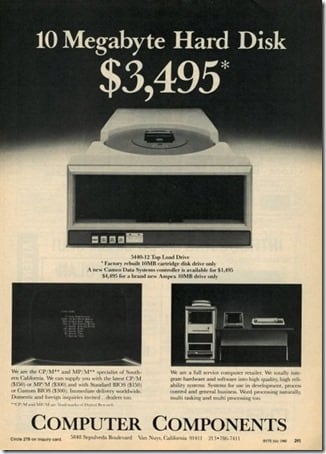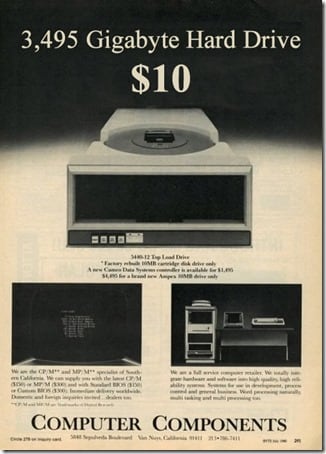Ok, I know. Talking about storage solutions or what the top storage trends are is not exactly the #1 topic on people’s minds. In fact, I would say that we all take storage for granted…that is, until we RUN OUT of storage or a hard drive crashes or our storage solution is incredibly slow. And, many of us simply don’t know the intricacies and complexities that make up today’s storage environments.
Storage has evolved. Tremendously. Especially over the past years. When we look at this 1980’s print advertisement, we almost find it comical.
Let’s make the math simple. For $3000, you can get a 10 MB hard drive – that’s TEN MEGABYTES folks. $300 per megabyte. If those prices existed today, the common 500 GB hard drives in our desktop computers would cost $150,000,000. Ok, that’s a silly calculation. We all know that storage has gotten smaller, faster and cheaper. There must be a Moore’s Law for Storage, you say. I say, there actually is – Kryder’s Law – which says that magnetic disk area storage density is increasing at a rate faster than Moore’s Law and the doubling of processor speeds.
With a little Photoshop magic, we can make that 1980’s ad a bit more relevant for today.
Not only has storage become much less expensive, it’s become faster and much more complex. Modern enterprise storage solutions offer redundancy as well as speed, and, the management tools allow for an average IT manager to create storage solutions like an IT superhero.
IBM boils the top storage trends into the following:
- Eliminating wasted empty storage space.
- Flash storage brings greater speed without needing solid state drives.
- Big Data is driving parallel and scalable storage environments.
- Storage managers need to understand efficiency, capacity, energy and administration.
- IT conversations are now spread up the organization to the C-suite.
- More storage solutions are coming from off-the-shelf hardware than enterprise storage hardware.
- Organizations are re-evaluating traditional roles of storage media.
- Software-defined storage environments allow for greater flexibility.
- Easy-to-use consumer interfaces are causing enterprise GUI’s to evolve.
- Unified storage environments are reducing hardware and management needs.
Better yet, take a look at their infographic below (you can also download a PDF version). Be ready to scroll a bit!
Personally, I believe there are four core changes to storage that are driving its success:
- Increased density – this allows for more data to be placed within a smaller physical space.
- Decreased cost – as manufacturing efficiencies and automation continue to drive down production costs, the end user is being passed on these savings.
- Increased speed – the read/write/access speeds getting faster through solid state and flash drives. (And data transfer speeds are increasing dramatically as well.)
- Increase of Big Data analytics – more different and unrelated types of data is being created from more sources with different types of data sets than ever before.
As larger data sets are created, managed, and manipulated, especially with the introduction of massive social data sets, and as these data sets are merged with others to create new relationships and data discoveries, there will be an increased dependence on extremely large, fast and efficient data storage mechanisms. Many companies call cloud storage a magical elixir that grows in size as you feed it more data. But, we all know that behind the scenes are arrays, racks and data centers filled with varying types of RAID configurations and hard drive storage types (NAS, SAN, SSD, Flash-based, Hybrid, etc.)
Corporations are demanding easy-to-understand and manage storage solutions now. It’s what gives them a competitive edge, especially as more organizations are turning to Big Data to better analyze their prospects and customers’ buying behaviors and patterns.
So, is storage trendy? Or following a technology trend? Actually, I would say both. Big Data is the word du jour, much the way cloud was hot and is now established. And storage technology is actually beating out Moore’s Law (thanks Kryder for drawing that line in the sand).
I’m predicting that in just a few years, we will be able to buy multiple terabyte drives for just a few dollars and these drives will be the size of a coin. They will self-replicate with other paired drives automatically. They will be network-aware and extremely fast. Consumers will be unaware of the storage sizes within their devices, for example smartphones will have dynamically-expandable, network-attached cloud storage. Oh wait, we have all of this now!
Where do you think the next evolution of technology will be? Compute? Networking? Storage? Will this trifecta converge much the way we have Operating Systems on a chip? Or will they expand on their own like the way software defined networking has (e.g., the next generation of networks)? Leave me a comment and let me know your thoughts.

HTD says: Storage is evolving quickly…are you keeping up?





